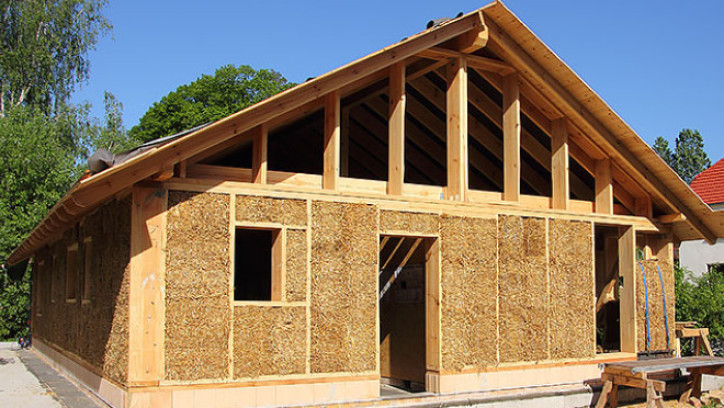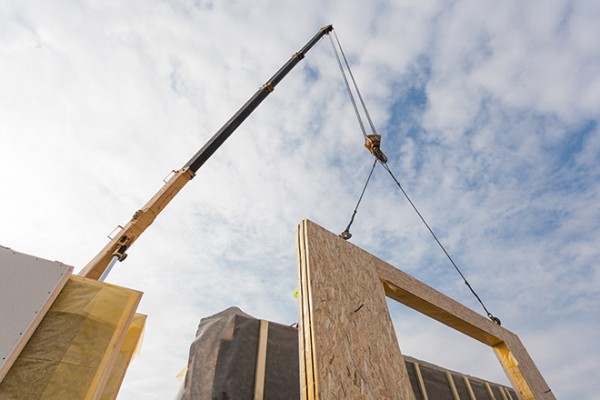Other types of construction
Last updated: 9 August 2023

There are many types of less common construction which may provide distinct benefits for your project.
While many people think of framed and solid construction types first, there are a number of less common construction methods that may suit your project better. This list is by no means exhaustive – talk to your designer to find out more.
Straw bale construction
What is straw bale construction?
Straw is normally a waste product and can be a cheap building material. It consists of stalks and leaves of various cereal crops, without the seeds. While it has been used in construction for hundreds of years in parts of Europe and North America, it is a more recent entrant into the New Zealand construction scene.
Straw bale construction is most likely to be used for single-storey buildings. Because of the thickness of the walls, other types of construction may be more practical for small urban sites. The need for a concrete footing means straw bale buildings usually need a flat building platform. The site must be well drained.
While straw bale walls can be load-bearing, it is much easier to design a post and beam or timber-framed construction to withstand lateral loads, with straw bale infill. Dry bales of straw are tightly stacked like big blocks on a continuous concrete foundation with a damp-proof membrane underneath. The bales are then wired together, and plastered with a breathable plaster to stop moisture build up and prevent straw rotting. The finished wall can look like a stucco or adobe wall.
Wind-driven rain makes demands on design and construction of straw bale houses, making it unsuitable for areas of high wind and heavy rainfall.
Straw must stay dry to prevent it from rotting or supporting the growth of mould. Because of this, straw bale homes have very wide overhangs, a water resistant yet breathable plaster and coating system, and proper flashings at windows, doors and junctions. These systems must be carefully maintained to keep water out – the plaster must be crack-free and needs to be regularly recoated.
Only use experienced building professionals
Because of the sensitivity of the construction to moisture, it is essential to have the project designed, supervised and built by people who have experience with straw bale buildings. Currently there is not a New Zealand Standard for straw bale constructions so professionals will need to be engaged to demonstrate the building’s compliance with relevant Building Code clauses.
Straw bale homes need to meet the same earthquake resistance performance requirements as other types of construction. Bales are fairly thick, and if locked into the post and beam framework will generally have sufficient stability to withstand lateral forces such as wind and earthquakes. The post and beam structure must be well braced. However, cracking to the plaster is likely to occur and will need regular maintenance.
Because straw bales are compressed during construction making them more likely to smoulder in the early stages of a fire, it's important that the plaster and linings encase the straw bales, limiting the potential for fire.
As long as the straw bales are carefully stored during construction and the plaster and linings are maintained in good condition, mice and other vermin are generally not an issue.
Straw bales have excellent thermal insulation properties since they are thick, trap air and do not conduct heat well. They are also very good sound insulators.
The large eaves that are required to protect the walls from driving rain also reduce the amount of sun that can enter the building. The thick walls also mean deep window recesses, which further reduces the amount of sun. Because of this, some straw bale homes use other construction methods (eg timber or concrete) with smaller eaves on the northern wall to allow sun to get in.
Earth construction
The most common types of earth construction are rammed earth, earth brick, poured earth, pressed earth brick, adobe and cob.
Rammed earth and earth brick are methods of construction with a long history. The remnants of earth buildings thousands of years old have been found in arid regions of the Americas, and the method has been used for centuries in parts of Europe, Asia, Africa, and the Middle East. In New Zealand, there are a number of examples of earth construction from early European settlement – one example, Pompallier House in Russell, was built from rammed earth in the 1830s.
Like straw bale construction, earth construction is best suited to dry climates without driving rain, and usually requires wide eaves for weather protection. It needs to be well sealed on the outside to prevent absorption of water.
Earth construction is high in mass, so can be used in place of concrete for thermal storage. Earth walls do not usually have an insulation layer added and therefore only provide limited thermal performance.
Structural insulated panels
Structural insulated panels, or SIPs, are large insulated panels that have been used overseas for several decades. They consist of a foam insulation core, sandwiched between two structural linings to create a load-bearing panel.
 Structural insulated panel
Structural insulated panelThe materials vary in combination. SIPs typically require building wrap and a cavity between the outer face and the cladding for weathertightness reasons.
SIPs are usually very good insulators, and because they have no framing inside the panels, there are very few thermal bridges. SIPs are often used in high-performance homes due to their thermal performance.
SIPs homes are typically very airtight. They must have adequate externally sourced ventilation to maintain good air quality indoors, and prevent internal moisture issues which can result in moisture, mould and mildew damage to the home.
The fire resistance of the cladding and linings will provide most of the protection from fire. Some types of SIPs have fire-resistant linings on both sides, and many have a fire retardant insulation core.